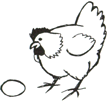Ribonucleic acid (RNA) – the biomolecule which can do it all
Sidney Altman and Thomas Cech have independently studied how the genetic code is transferred from DNA to RNA. They knew, however, that part of the genetic information is not required and must be removed from RNA before the RNA molecule can be utilized by the cell. While searching for the catalysts of RNA maturation, Altman and Cech discovered that these enzymes were composed of catalytic RNA, and not of protein.
Sidney Altman studied the enzyme RNase P, which is found in e.g. intestinal bacteria. RNase P activates a special kind of RNA molecule called tRNA (transfer RNA) by removing a portion which is unnecessary for its function. The enzyme RNase P has the unusual property of containing not only a protein molecule, but an RNA molecule as well. Surprisingly Altman demonstrated that it is the RNA molecule which acts as a biocatalyst.
Thomas Cech studied an RNA molecule from the primitive unicellular animal Tetrahymena. He discovered that an unnecessary piece of RNA is removed from the middle of this molecule and that the loose ends thus formed are then joined together. It created a sensation when he showed that the RNA molecule itself catalyzes this reaction. The portion of the RNA molecule which is removed modifies itself subsequently so that it can function, among other things, as an RNA-synthesizing enzyme. This means that catalytic RNA can also make new RNA.
The work of both Altman and Cech indicates that the catalytic capacities of RNA molecules are intimately dependent on their three-dimensional structures, as is the case with enzyme proteins.
 |
By the discovery of catalytic RNA the Nobel laureates have shown that neither the chicken nor the egg came first. RNA molecules can possess all the properties required of the original biomolecule: They can be both genetic material and enzymes at the same time.
Nobel Prizes and laureates
Six prizes were awarded for achievements that have conferred the greatest benefit to humankind. The 14 laureates' work and discoveries range from quantum tunnelling to promoting democratic rights.
See them all presented here.
